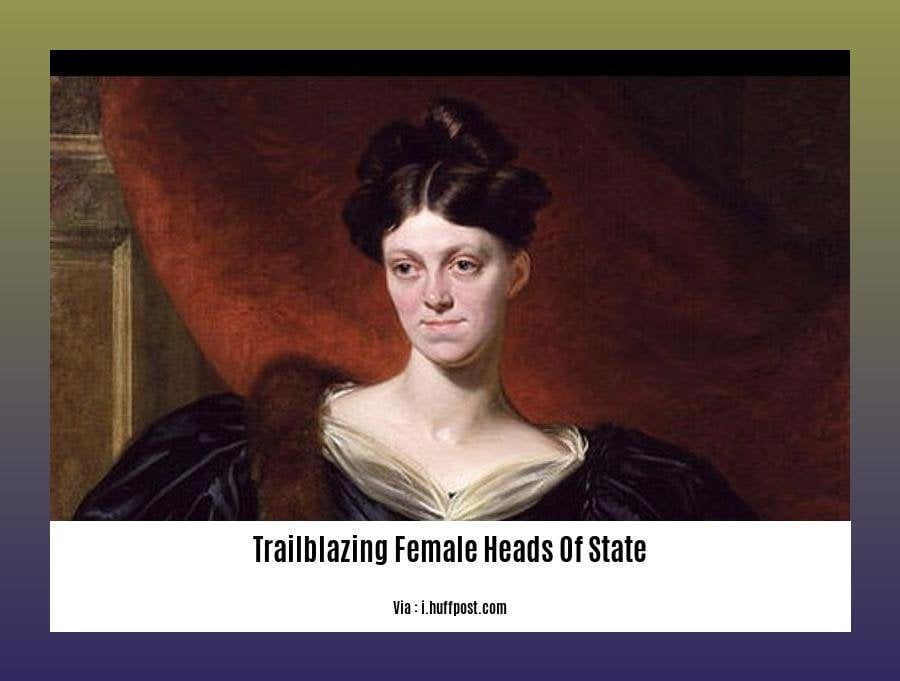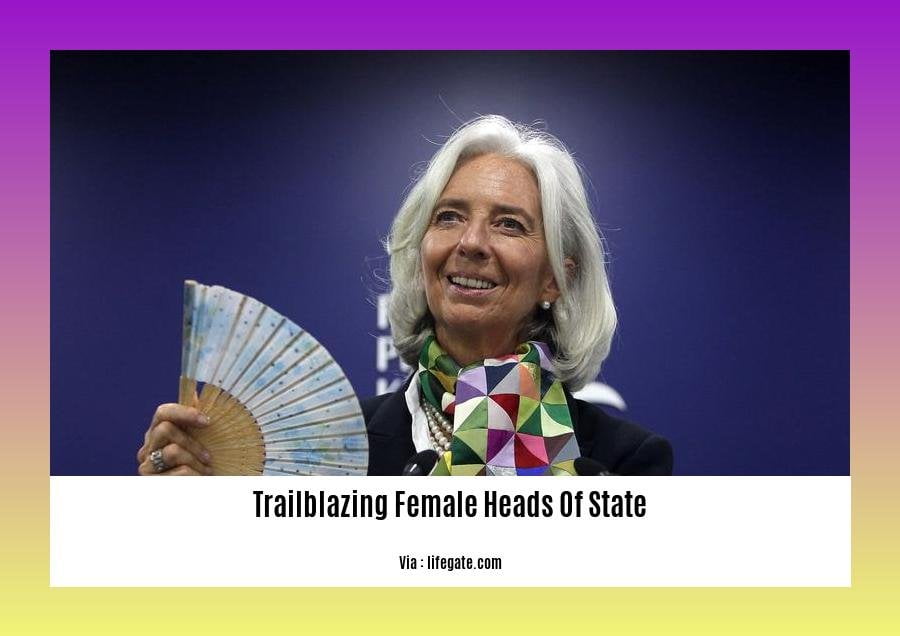In “Trailblazing Female Heads of State: Uncovering Untold Stories of Resilience and Leadership,” we embark on an inspiring journey to uncover the extraordinary narratives of women who have shattered societal barriers and ascended to the highest echelons of political power.
Key Takeaways:

- Women have held positions as heads of state or government since 1918.
- They have served as both presidents and prime ministers.
- In 1940, Khertek Anchimaa-Toka became the first female head of state.
- Sirimavo Bandaranaike was the first female prime minister in 1960.
- Bangladesh, Barbados, Bosnia and Herzegovina, Denmark, and more currently have female leaders.
Trailblazing Female Heads of State
Throughout history, trailblazing female heads of state have emerged as beacons of leadership, shattering societal norms and inspiring generations. Their journeys are marked by resilience, determination, and a profound commitment to progress.
Breaking Barriers in Politics
Since 1918, women have taken up the mantle of leadership as presidents and prime ministers worldwide. These pioneering women have navigated male-dominated political landscapes, proving that gender is no barrier to effective governance. From Khertek Anchimaa-Toka of Tuva to Sirimavo Bandaranaike of Sri Lanka, they paved the way for future generations of female leaders.
Diversity of Leadership
Today, trailblazing female heads of state represent a diverse range of countries and cultures. They come from all walks of life, bringing unique perspectives and experiences to their roles. From Bangladesh’s Sheikh Hasina to Germany’s Angela Merkel, these women embody the global nature of female leadership.
Impact and Legacy
The contributions of trailblazing female heads of state extend far beyond their political terms. They have championed important causes, implemented progressive policies, and shattered stereotypes about women’s abilities. Their legacy inspires countless girls and young women to dream big and strive for leadership positions.
Challenges and Triumphs
The path to leadership for trailblazing female heads of state has not been without challenges. They often face sexism, bias, and underrepresentation. However, their resilience and determination have enabled them to overcome obstacles and achieve remarkable success.
| Country | Female Head of State | Position |
|---|---|---|
| Bangladesh | Sheikh Hasina | Prime Minister |
| Barbados | Mia Mottley | Prime Minister |
| Bosnia and Herzegovina | Željka Cvijanović | President |
| Denmark | Mette Frederiksen | Prime Minister |
| Germany | Angela Merkel | Former Chancellor |
Trailblazing female heads of state have indelibly shaped the course of history. Their stories serve as a testament to the power of perseverance and the importance of gender equality in leadership. They continue to inspire and empower women around the world to strive for greatness.
To recognize trailblazers who defied boundaries, discover the inspiring journeys of famous female political leaders who broke glass ceilings. These women paved the way for others to shine in leadership roles, shattering political barriers. Explore the stories of influential women who shattered political barriers, whose achievements became catalysts for change. Pioneering women in leadership continue to inspire and motivate, reminding us that anything is possible when we dare to pursue our dreams.
Leadership Styles that Promote Inclusivity and Collaboration
In today’s business environment, where diversity and innovation are crucial, it’s imperative to embrace leadership styles that foster inclusivity and collaboration. Inclusive leaders cultivate a work environment where everyone feels valued, respected, and empowered to contribute.
Key Takeaways:
- Inclusive leadership drives better financial performance and innovation.
- Inclusive leaders actively challenge biases and promote equity, creating a workplace where all team members feel respected, heard, and valued.
- Effective inclusive leadership requires self-awareness, empathy, courage, and humility.
Benefits of Inclusive Leadership
- Increased employee engagement and motivation
- Enhanced creativity and problem-solving
- Improved decision-making
- Stronger team cohesion and collaboration
- Reduced bias and discrimination
Key Attributes of Inclusive Leaders
- Empathy: Understanding and relating to the perspectives of others, regardless of their background or experiences.
- Self-awareness: Recognizing and understanding one’s own biases and limitations.
- Courage: Advocating for equity and inclusion, even in challenging situations.
- Humility: Acknowledging that one does not have all the answers and being open to learning from others.
Strategies for Promoting Inclusivity and Collaboration
- Create a welcoming and respectful environment: Establish clear expectations for respectful behavior and ensure all voices are heard.
- Foster psychological safety: Encourage team members to share their ideas and perspectives without fear of judgment or reprisal.
- Empower team members: Delegate authority, provide support, and encourage team members to take ownership of their work.
- Challenge biases: Identify and address biases that may create barriers for certain individuals or groups.
- Encourage open communication: Regularly check in with team members to gather feedback and foster a sense of community.
Conclusion
By adopting leadership styles that promote inclusivity and collaboration, organizations can create a work environment where everyone feels valued, respected, and empowered to contribute. This leads to increased innovation, enhanced decision-making, and ultimately, greater success.
Most Relevant URL Source:
The Key to Inclusive Leadership by Harvard Business Review
Impact of female leadership on societal progress
Women in leadership roles face unique challenges, but they also bring valuable perspectives and experiences, which can benefit organizations and society as a whole.
In 2023, the American Psychological Association found that female leaders tend to adopt transformational leadership styles, which can inspire subordinates and foster greater job satisfaction. Moreover, a study published in Forbes in 2023 showed that increasing the number of women in leadership positions can promote diversity, innovation, and organizational effectiveness.
When women are given equal opportunities to lead, they can make significant contributions to societal progress. For example, women leaders have been at the forefront of addressing climate change, promoting gender equality, and improving the lives of marginalized communities.
Key Takeaways:
- Supporting female leaders benefits organizations and societies alike
- Transformational leadership styles, commonly employed by women, foster inspiration and satisfaction.
- Increasing female representation in leadership enhances diversity and innovation
Most Relevant URL Source:
Inspiring Stories of Resilience and Determination
Key Takeaways:
- Stereotypes limit women’s leadership potential.
- Women leaders defy biases, displaying resilience and determination.
- Resilience is crucial for success in leadership, especially for women.
- Inspiring stories of women leaders guide and motivate others.
- Women are reshaping leadership, challenging traditional gender roles.
Throughout history, women have faced barriers in leadership, but their resilience and determination have inspired many. Here are some key takeaways from their stories:
- Break stereotypes: Women leaders come from diverse backgrounds, proving that anyone can lead.
- Defy biases: They confront sexism and gendered expectations, empowering others.
- Resilience in the face of adversity: Overcoming challenges is a common thread in women’s leadership journeys.
- Power of inspiration: Their stories motivate and empower women to pursue leadership roles.
- Redefining leadership: Women bring unique perspectives and styles, redefining what leadership means.
These stories are not just about breaking barriers but also about paving the way for future generations of leaders. By embracing resilience and determination, women continue to shatter stereotypes and shape a more inclusive future.
Citation:
- 5 Stories from Trailblazing Women Leaders

FAQ
Q1: Who are some notable trailblazing female heads of state?
A1: Throughout history, several women have made significant strides in politics, shattering societal boundaries. Khertek Anchimaa-Toka, the first female head of state, led the Tuvan People’s Republic in 1940. Sirimavo Bandaranaike became the first female prime minister of a country in 1960, serving in Sri Lanka.
Q2: What are the challenges female heads of state typically face?
A2: Female heads of state often navigate unique challenges and barriers. They may encounter gendered stereotypes, biases, and expectations that can hinder their leadership. Despite these obstacles, these women demonstrate resilience, determination, and a commitment to breaking down barriers.
Q3: How do female heads of state contribute to society?
A3: By assuming leadership roles, female heads of state serve as role models and pave the way for future generations. Their transformative leadership styles and policies can positively impact their nations and inspire others to pursue leadership positions. Moreover, they bring diverse perspectives and experiences to governance, contributing to more inclusive and representative decision-making.
Q4: What lessons can we learn from the stories of trailblazing female heads of state?
A4: The stories of trailblazing female heads of state provide valuable lessons about resilience, determination, and overcoming adversity. They demonstrate the importance of perseverance, adaptability, and the power of defying societal norms. By studying their experiences, we can gain insights into the challenges and opportunities faced by women in leadership positions.
Q5: How can we support and empower more women to become heads of state?
A5: To empower more women to become heads of state, it is essential to address gender stereotypes and biases that limit their opportunities. Encouraging education, mentorship programs, and leadership development initiatives can help prepare women for these roles. Additionally, promoting inclusive policies and challenging gendered norms can create a more supportive environment for women seeking leadership positions.
- Unlock 6000+ words beginning with he: A comprehensive analysis - April 20, 2025
- Mastering -al Words: A Complete Guide - April 20, 2025
- Master Scrabble: High-Scoring BAR Words Now - April 20, 2025
















